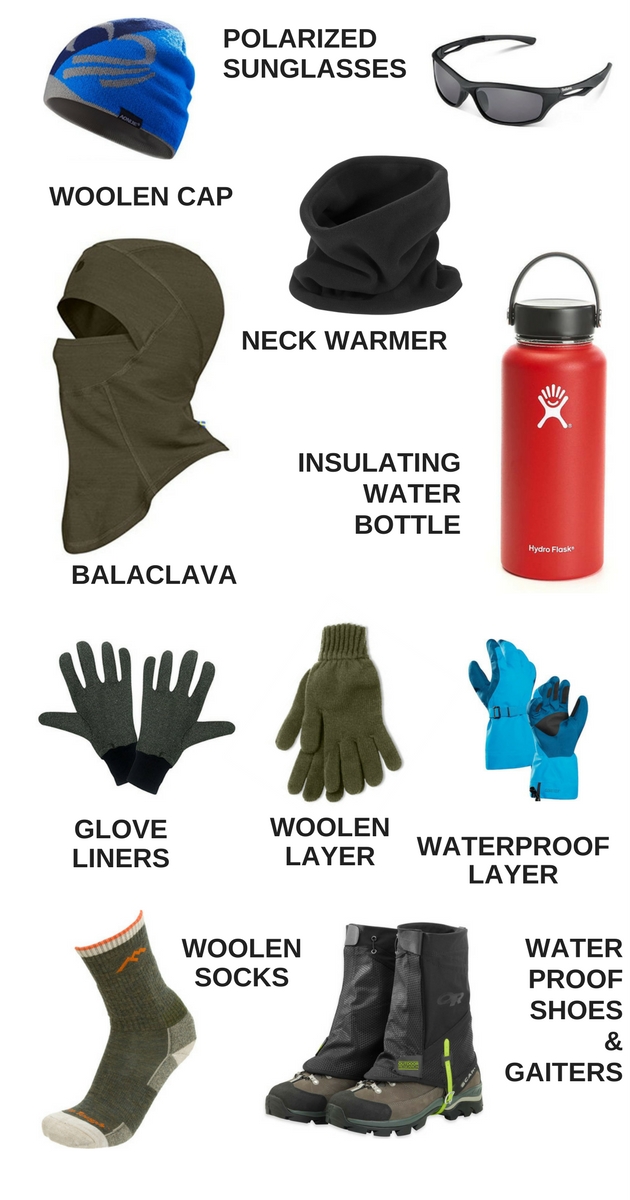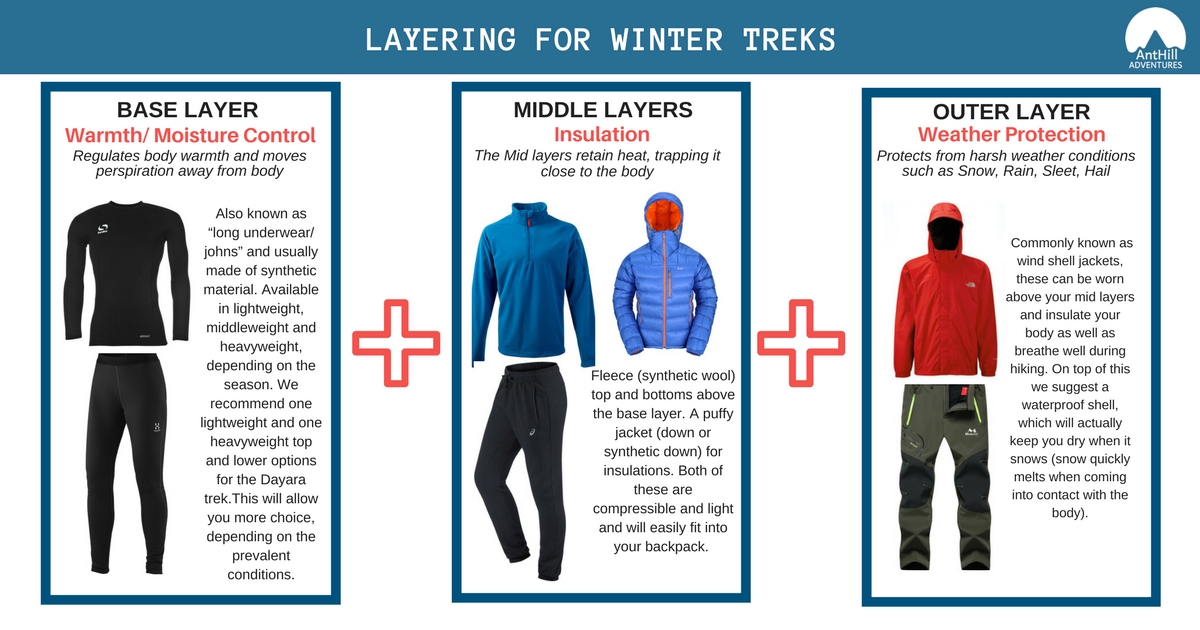The human body is not designed for the cold weather conditions in the Himalayan winter. Most of us are used to warmer climates and find ourselves like ‘fish out of water’ when exposed to snow and wind-chill conditions. It is crucial for us to prepare by layering for winter treks intelligently to be able to enjoy the beautiful landscape and prevent hypothermia. Do remember that if you are warm you will full enjoy the magic of winter in the mountains.



THE LAYERING SYSTEM
To begin with, it is important to understand the natural heat sources for the body. The primary source is what is known as basal metabolism. This is nothing but the heat produced by the body to sustain life. When we move or exercise a second heat source quickly kicks in to action – exercise metabolism. To stay warm in the harsh winters, it is important to trap this heat and decrease heat loss. Here is where the clothing we chose for a winter trek is of utmost importance.
The first principle is to dress in layers. This helps trap the warmth your body produces. The right layering will be instrumental in dealing with the cold weather.
The second principle of the layering system is that your clothing must be made of material that offers protection from the wind and precipitation and at the same time keep you as dry as possible from the sweat produced by the body. From the layering materials available for winter wear, you actually have only three to choose from: wool, synthetics, and down.
So which materials are best suited for trekking in winters?
WOOL: It is a great insulator. It even retains its abilities as an insulator when wet! One down side is that it is fairly heavy. Too much wool in your wardrobe will make your pack heavy.
SYNTHETIC: The ability for synthetics to insulate can be compared to wool. They are made to feel soft and comfortable against your skin. The fibres do not absorb or retain moisture and actually wicks it away from the body. The material is tightly woven together and can help keep the wind out. If coated it even protects from precipitation (rain,snow).
DOWN FEATHER: Down feather material clothing ranks as one of the best options. It will keep you snug when everything else fails.
THE 3 LAYERS
BASE LAYERS: Commonly known as “long underwear” and usually made of synthetic material. Available in lightweight, middleweight and heavyweight, depending on the season. We recommend one lightweight and one heavyweight top and bottom for the Dayara trek. This will allow you more choice, depending on the prevalent conditions.
MIDDLE LAYERS: These can take the form of jackets, sweaters and pullovers. Again, it is suggested that fleece (synthetic wool) be used for the layer above the base layer and it must have a full front zipper, to help you regulate temperature. For the bottom mid layer, we suggest fleece pants with partial zippers, to help you dress and undress. We also recommend another puffy jacket in case you feel particularly cold. Both of these are reasonably compactable and will easily fit into your backpack.
OUTER LAYER: Commonly known as wind shell jackets can be worn above your mid layers and insulate your body as well as breath well during hiking. On top of this we suggest a waterproof shell, which will actually keep you dry when it snows (snow quickly melts when coming into contact with the body).
Trek Tip!
In the wilderness climate conditions will vary during the course of the day and similarly the body will produce more heat when hiking as compared to sleeping in the tent. This is where the true benefits of layering work. It gives you the freedom to shed or add layers as and when you need!
It is very important for you to wear all the clothes together when you are trying them on in the store. The outer layer must be large enough to cover all the other layers.
Must have winter accessories

Keeping your extremities warm
In cold climates the body goes into a self-preservation zone of sorts. Warm blood rushes from the extremities towards the vital organs, to protect them from possible damage. Hence, It is crucial that the Head, Hands and feet are well protected from the elements.
HEAD GEAR: A good woollen cap and a Balaclava are a must.
GLOVES: We recommend a glove liner (base layer for gloves that does not compromise finger dexterity). On top of this you must wear a good pair of thick woollen gloves. Finally, a waterproof glove shell is needed to prevent the wool from getting wet (layering for your hands!).
SOCKS: Again, use the layering principle. Wear a pair of synthetic liners followed by thicker woollen socks. This helps wick moisture away from your feet, into the thicker socks. It is important to carry a few pairs of woollen socks.
SHOES: Last but far from the least important is your trekking shoes or boots. If you are planning on saving money on the winter gear do it somewhere else. Your feet are the farthest from your body’s core and tend to get cold the fastest. You must select a pair that is large enough to fit the thick socks and keep the dead air warm next to your feet. They must insulate your feet from the cold snow and rain.
GAITERS: These are leg coverings that strap around your leg from the instep to your lower leg (just below the knee). They prevent snow from entering your boots.
INSULATING WATER BOTTLE: This will help you hydrate and keep warm. Fill will it with hot water and slip it in with you inside the sleeping bag for a cozy night’s sleep!
As we get prepared to head into the mountains this season, here’s a great checklist to stay safe and tackle mountain sickness!
https://www.bookmundi.com/t/health-and-safety-while-trekking



One thought on “Going Winter Trekking? Here is how to layer right!”
Informative! I was looking for clothes to wear during winter treks and stumbled on your blog I must your blog is very helpful for me. I will share this article with my friends.
Comments are closed.